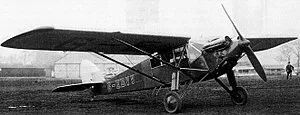Moth, Hawk (Total: 3, Canadian: 3, Group 0)
de Havilland Moth, Hawk

The DH.75 Hawk Moth was the first of a family of high-wing monoplane Moths, and was designed as a light transport or air-taxi for export. The aircraft had a fabric-covered steel-tube fuselage and wooden wings. The Hawk Moth was first flown on 7 December 1928 from Stag Lane. The first aircraft used a 200 hp (149 kW) de Havilland Ghost engine. This engine comprised two de Havilland Gipsys mounted on a common crankcase to form an air-cooled V-8. With the Ghost, the aircraft was underpowered and a 240 hp (179 kW) Armstrong Siddeley Lynx radial engine was fitted to it and all but one production aircraft. Changes were also made to the structure including increased span and chord wings and the aircraft was redesignated the DH.75A.
In December 1929 the first aircraft was demonstrated in Canada with both wheel and ski undercarriage. Following trials with the second aircraft on floats, the Canadian government ordered three aircraft for civil use. The first Canadian aircraft (actually the first Hawk Moth) did not have doors on the port side and could therefore not be used as a floatplane, so it was used by the Controller of Civil Aircraft. Further tests were carried out by de Havilland Canada in 1930, and the second and third aircraft were cleared to use floats. With restrictions on payload when fitted with floats the Canadian aircraft were used only on skis or wheels. In an attempt to compete with American-designed aircraft, the eighth aircraft was produced as the DH.75B with a 300 hp (224 kW) Wright Whirlwind engine. Production was stopped and two aircraft were not completed. Wikipedia
Moth, Hawk serial G-CYVD
s/n GCYVD
m/d D.H.75A
c/n 343
de Havilland
G-CYVD
Known Units:
Used at Camp Borden, Ontario. Other registrations assigned included G-AAFW (before shipping to Canada) and CF-CCA (for use by Controller of Civil Aviation in 1930). First registered to de Havilland in the UK as G-AAFW on 7 November 1929. Believed to be in Canada by December 1929. Originally issued to Controller of Civil Aviation, transferred to RCAF in 1931. SOC 8.10.35. This registration was re-used by a Department of Transport Beech 17 from 1938.last update: 2025-November-19
1930-July-16 Registration Change Registered to Department of National Defence 2020-07-18
1931 Serial Change Transferred to the Directorate of Civil Government Air Operations, became G-CYVD . 2019-08-20
1935-October-08 Struck off Strength 2020-07-18
Moth, Hawk serial G-CYVL
s/n GCYVL
m/d D.H.75A
c/n 707
de Havilland
G-CYVL
Known Units:
Assembled by DHC. Taken on strength by RCAF on 19 December 1930. Used for trails at RCAF Station Rockcliffe, Ontario. Landing gear collapsed on landing on 17 January 1931, while testing skis at Rockcliffe. Repaired, returned to service. Category A crash at Longueil, Quebec on 27 June 1931.last update: 2025-November-19
1931-November-20 Struck off Strength Struck off after crash, see comments. 2019-08-20
Moth, Hawk serial G-CYVM
s/n GCYVM
m/d D.H.75A
c/n 708
de Havilland
G-CYVM
Known Units:
Assembled by DHC. Used for trails at RCAF Station Rockcliffe, Ontario. Used at Camp Borden, Ontario. SOC 5.10.34last update: 2025-November-19
1934-October-05 Struck off Strength 2019-08-20